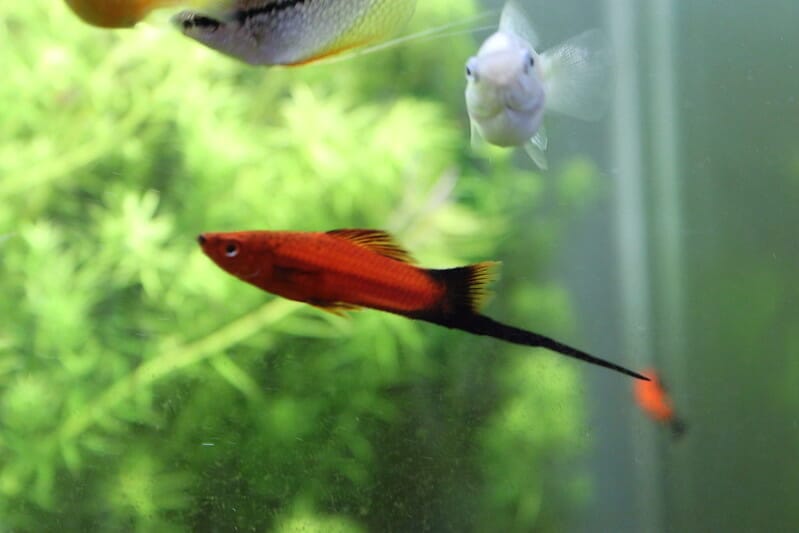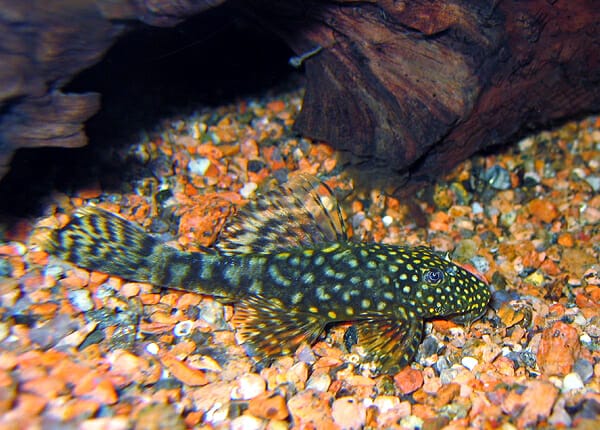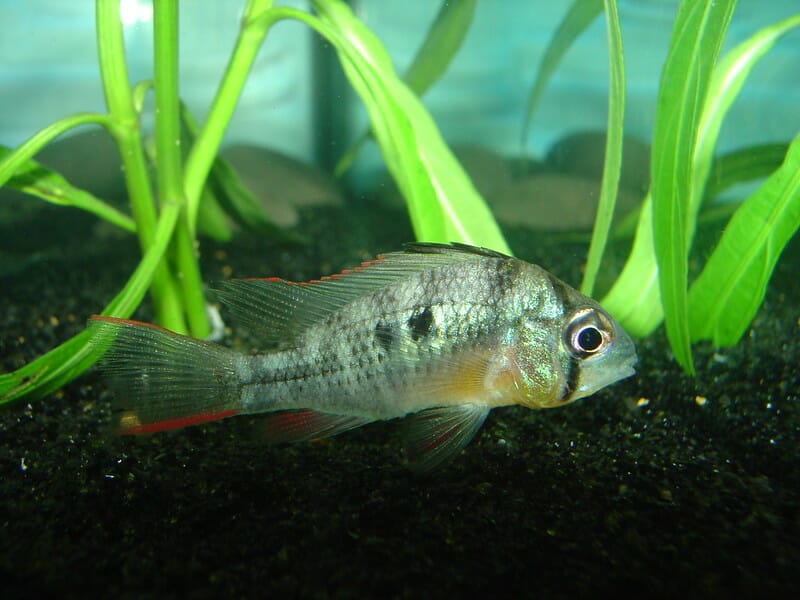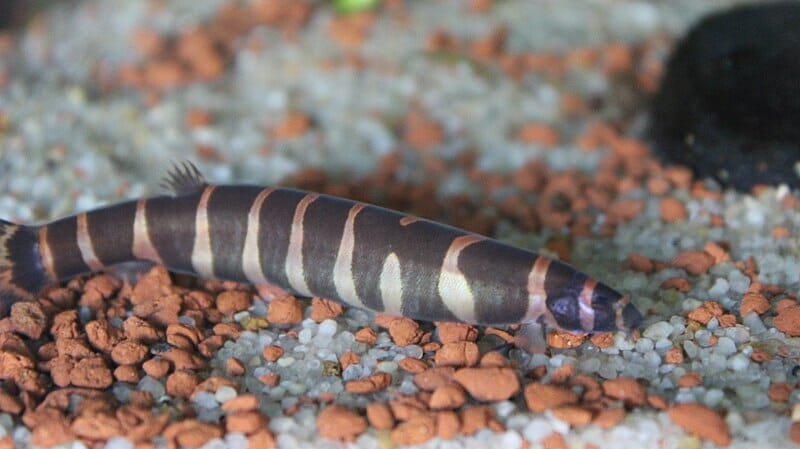Many people want to get their first fish tank and start their freshwater aquarium.
But one thing that holds most of them back is that they think that it is very difficult to care for or a fish.
And honestly, it is actually a lot of work if you want to put some delicate fish like Guppies in your aquarium.
But there are some fish that are way easy to care and in this article, I am going to share with you the same.
Table of Contents
13 Easy to Care Freshwater Fish
| FISH | SCIENTIFIC NAME | CARE LEVEL | MAXIMUM SIZE | AVERAGE LIFESPAN | DIET | WATER TEMPERATURE | WATER pH | WATER HARDNESS | MINIMUM TANK CAPACITY | BREEDING |
|---|---|---|---|---|---|---|---|---|---|---|
| Betta Fish | Betta splendens | Easy | 2.25-3 inches | 3-5 years | Omnivores | 77° and 86° F | 6 - 7.5 | 5° to 20° dH | 2 gallons | Egg layer |
| Common Goldfish | Carassius auratus | Easy | 3 to 5 inches | 10 - 30 years | Omnivores | 40°F - 80° F | 6 - 7.5 | 5° to 20° dH | 20 gallons | Egg layer |
| Platy | Xiphophorus maculatus | Easy | 2 inches | 2 - 3 years | Omnivores | 65°F - 77° F | 7 - 8 | 10° to 25° dH | 10 gallon | Livebearer |
| Black Molly | Poecilia sphenops | Easy | 4.5 inches | 5 years | Omnivores | 70° - 80° F | 7.5 – 8.2 | 10° to 25° dH | 20 gallons | Livebearer |
| Swordtail | Xiphophorus helleri | Easy | 5 inches | 3 - 5 years | Omnivores | 72°F - 82° F | 7 - 8 | 9° to 15° dH | 10 gallon | Livebearer |
| White Cloud Minnow | Tanichthys micagemmae | Easy | 1.5 inches | 3 - 5 years | Omnivore | 60 F | 6 - 8 | 5°–19° dH | 10 gallons | Egg layer |
| Zebra Danios | Danio rerio | Easy | 2 inches | 5 years | Omnivore | 64° - 74° F | 6.5 to 7.0 | 5° to 12° dH | 10 gallon | Egg layer |
| Black Skirt Tetra | Gymnocorymbus ternetzi | Easy | 2 inches | 3 - 5 years | Omnivore | 75°F - 80° F | 6 - 7.5 | 5° to 20° dH | 20 gallons | Egg layer |
| Bristlenose Pleco | Ancistrus Cirrhosus | Easy | 5 inches | 5+ years | Herbivore | 73° - 81° F | 5.8 to 7.8 | 2° to 30° dH | 30 gallons | Egg layer |
| Kribensis Cichlid | Pelvicachromis pulcher | Easy | 4 inches | 5 - 8 years | Omnivore | 75°F - 79° F | 6 - 8 | 5° to 20° dH | 30 gallons | Egg layer |
| Harlequin Rasbora | Trigonostigma heteromorpha | Easy | 2 inches | 3 - 5 years | Omnivore | 72°F - 80° F | 5.5 - 7.0 | Up to 12° dH | 10 gallons | Egg layer |
| Bolivian ram cichlids | Mikrogeophagus altispinosus | Easy | 3.1 inches | 6 years | Omnivore | 73-82° F | 6.0-7.5 | 5° — 15° dH | 40 galoons | Egg layer |
| Kuhli Loach | Pangio kuhlii | Intermediate | 4 inches | 10 years | Omnivore | 75° –86° F | 6.0–6.5 | up to 10° dH | 20 gallons | Egg Layer |
1. Betta Fish

Betta fish is the second most popular fish in the aquarium hobby.
It is a very popular phase because of its beauty, color, and low maintenance.
You can keep a Betta fish in a 2.5 gallon tank. However, for optimum health, you should keep it in a 5-gallon tank.
Betta fish is very cheap as well.
Betta fish grows up to 3 inches and it lives for about 3 to 5 years.
The betta fish really looks cool because of its colors.
The males are more colorful than females.
Betta fish is also called Siamese fighting fish because it fights with another male of the same species.
That’s why you can’t keep two betta fish males in one fish tank.
If you do so, they will fight until only one of them remain.
Betta fish is very territorial and it fights with other male fish of the same species to protect their eggs.
But you can put Betta fish with other fish like an Amano shrimp, Bristlenose plecos, Kuhli Loaches, etc.
Water parameters
The ideal temperature for Betta fish is 77-86 degrees Fahrenheit.
It requires a pH between 6 to 7.5.
The hardness of the water should be between 5 to 20 dH.
Food
Betta fish are omnivorous and in the wild, they eat insects, larvae and algae.
Betta fish usually don’t eat live plants.
So, if you are planning to keep some aquatic plants in your aquarium then Betta fish will not harm them.
The best food for Betta fish is live brine shrimp, bloodworm, mosquito larvae.
You can also feed frozen live food and Betta pellets.
Frozen food doesn’t have any risk of transferring disease into your aquarium fish.
2. Common Goldfish

When it comes to aquarium Goldfish is the first fish that came into everybody’s mind.
It is the most popular fish in the aquarium hobby.
It is also a very hard fish which makes it ideal for the beginners.
The Goldfish can grow very big up to 5 inches and it can live for about 10- 30 years.
It is not very common that a Goldfish live for 30 years.
Generally, in a fish tank, it lives for about 10 years.
The only thing you have to take care of if you are starting out with Goldfish is the filtration because Goldfish is a very messy fish.
Goldfish produces lots of waste which produces ammonia in the aquarium.
Ammonia is very harmful to the fish and it can even cause the death of the fish.
You should put Goldfish into a large tank of about 20 gallons because this will help to dilute the ammonia level.
Besides, there are several ways to reduce ammonia in an aquarium. You can check it out here.
As Goldfish is a cold-water fish you have to maintain a low water temperature between 40 to 80-degree Fahrenheit.
If the temperature rises and it stays high for a long time then it can cause permanent nerve damage in the Goldfish.
15 Mistakes Beginners Make with their Goldfish Tank (How to avoid them)
Also, some fancy Goldfish like fantail Goldfish are sensitive to very cold water.
Besides, Goldfish is a very hardy fish and it is very easy to maintain.
Water parameter
As mentioned above Goldfish is a cold-water fish so you should maintain a temperature of about 40 to 80 degrees Fahrenheit depending on the species of the Goldfish in your aquarium.
High temperatures can cause permanent nerve damage in Goldfish. so maintaining low temperature is very critical.
Goldfish require a pH between 6-7.5 and hardness of about 5 to 20 dH.
Tankmates
The best tank mates for Goldfish are other Goldfish.
But you can put some other fish like zebra danios, ghost and Cherry shrimp, Rosy barbs, Bristlenose plecos, white cloud mountain minnows, Apple snails, rubber nose plecos, dojo loaches with the Goldfish.
Food
Goldfish are omnivorous scavengers so they require both vegetarian and nonvegetarian diets.
In the wild, Goldfish eat insect larvae, mosquito larvae, small insects and even small fish to fulfill their nonvegetarian diet and they a nibble on plants to fulfill their vegetarian diet.
You can feed fish pellets, boiled vegetables, live and frozen bloodworms, brine shrimp, etc to the Goldfish.
You can also keep some fast-growing plants in the Goldfish aquarium so that Goldfish can snack on it.
Goldfish diet is high protein and low carb so you should only feed the fish food which is specially made for Goldfish because other generic fish food will not contain all the nutrients in similar quantities.
Besides, you can check out my ultimate guide about Goldfish food that contains 29 fish food alternatives you can feed to your Goldfish here.
3. Platyfish

Image by Marrabbio2 under CC BY-SA 3.0
image source under CC BY-SA 3.0
Platies are also very popular freshwater tropical fish.
Platies comes in various different color including salt and pepper, red wagtail and tuxedo.
There is a variety of platyfish which is called Mickey mouse.
Platyfish are very easy to breed and they are used in cancer research studies.
They grow up to 2 inches in size and the females are bigger than the males of the same age.
They live for about 2-3 years.
Platyfish are very peaceful generally but they can get aggressive during breeding.
So, you should keep at least two females with one male platy.
Water parameters
Platyfish require temperature between 65 degrees to Fahrenheit for their proper growth.
It requires a pH range between 7 to 8 and hardness between 10 to 25 DH.
Food
You can feed boiled and chopped vegetables as well as flakes to the platyfish.
Tankmates
You can put mollies, swordtail, guppies, corydoras, tetras, small barbs, gouramis with the platies.
4. Black Molly

Black Molly by Marrabbio under CC BY-SA 3.0
Black Molly is also one of the common fish in the aquarium hobby nowadays.
Black Molly can grow up to 4.5 inches and they can live up to 5 years.
Usually, females are bigger in size than males.
Black Mollies are omnivorous. They eat bloodworms, brine shrimp, etc.
They also eat algae so they are a great addition for your fish tank because they will help to keep algae in control.
Black Molly is an aggressive breeder so you should keep at least three females for every one male.
Black Mollies are also livebearers which means that the baby fish will come out free swimming.
The best part about Black Molly is that it is a very hardy fish and it can survive in almost any water condition which makes it ideal for the beginners.
Water parameters
The ideal temperature for Black Molly fish is from 70 degrees to 80 degrees Fahrenheit.
The ideal pH range is from 7.5 to 8.2.
Black Molly fish prefer hard water of about 15 to 30 dH.
Food
As mentioned above Molly fish are algae eaters.
They also eat vegetables like zucchini, cucumber and shelled peas.
Besides, you can also feed them bloodworms, blackworms, brine shrimp, flakes, etc.
Tankmates
Black Molly fish is usually very peaceful so you can put a lot of other fish with them like guppies, danios, tetra, swordtail, gouramis, platyfish and other Molly fish.
5. Swordtail

Image by Bernat Arlandis under CC BY-SA 2.0
Swallowtail is one of the most popular community tank fish.
It is very peaceful and easy to care which makes it ideal for beginners.
Swordtail is very easy to recognize from there the unique shape of its fin.
Males have a sword-like tail.
The Swordtail can grow up to 5 inches and it can live for 3 to 5 years.
Swordtail also comes in different colors.
The best part about the Swordtail fish is that it is a very hardy fish and it can easily adapt to a wide range of water conditions.
Swordtails are aggressive breeders so ideally you should keep at least three females with one male.
Swordtails are livebearers so the babies come out free swimming.
Water parameters
the ideal temperature for Swordtail fish is 72 to 82 degrees Fahrenheit.
The ideal pH range is from 7 to 8 and the hardness range is 9 to 15 dH.
Food
You can feed flakes, frozen or live foods like bloodworms, brine shrimp, etc to the swordtail fish.
Tankmates
You can put various types of tetras like neon tetra, red-eye tetra as well as catfish, mollies and platies with the swordtail fish.
6. White Cloud Minnow

Image source under CC BY-SA 3.0
White cloud minnow is also one of the Hardy fish in the aquarium hobby.
It is a very peaceful fish and you can put it with many other small peaceful fish.
You should avoid keeping White cloud minnows with other big fish as well as aggressive fish.
White cloud minnows are small fish and they can grow up to one and a half inches and live for about 3 to 5 years.
To get the richer color of White cloud minnow you should keep them in a bit cooler water than typical tropical fish water.
Also, you should not keep them in warm water for a long period of time because it can shorten their lifespan.
Water parameters
The ideal temperature for White cloud minnow is 60-degree Fahrenheit
The ideal pH range is 6-8 and the water hardness range age 6-19 DH.
Food
White cloud minnows are omnivorous so you can feed them a variety of foods like live or frozen bloodworms, brine shrimp, mosquito larvae, daphnia, flakes and even boiled vegetable in very small quantities.
Tankmates
White cloud minnows are a schooling fish so you should keep at least 6 fish in at least a 10-gallon tank.
They are very peaceful so you can keep them with other small peaceful fish.
Besides, you can keep them with Black skirt tetra, glowlight tetra, betta fish, dwarf gourami harlequin rasboras.
7. Zebra Danios

Image by Bernat Arlandis under CC BY-SA 2.0
Zebra danios are one of the most popular tropical fish in the aquarium hobby.
The best part about Zebra danios is that they are very hardy fish and they can survive in a wide range of water parameters which makes them ideal for beginners.
They are so hardy that some people use them to cycle their new fish tanks.
But this practice is not recommended at all because it can really stress out the fish.
They are schooling fish and usually do well in a group of at least 6.
Zebra danios are small fish and can grow up to 2 inches and they live for about five years.
Water parameters
the ideal temperature range for zebra danios is 64 to 74 degrees Fahrenheit.
The pH tolerance range is from 6.5 to 7 and the water hardness tolerance range is 5 to 12 dH
Food
Zebra danios can eat a variety of food. They can eat flakes, frozen or live bloodworms, brine shrimp, daphnia, etc.
Tankmates
You can keep other Danios with Zebra danios fish.
Besides, you can also put corydoras, tetras, swordtail, guppies, kuhli loaches, small barbs, etc with Zebra danios.
8. Black Skirt Tetra

Black skirt Tetra is also known as Black tetra or Black widow tetra.
It is very easy to care for fish which makes it ideal for beginners.
It is a very popular fish in the hobby and it is available in most of the pet stores.
It is a small schooling fish and you should keep them in at least a group of six.
Black skirt tetra is a small fish and it grows up to 2 inches.
It can live up to 5 years if you took good care of it.
You should avoid putting this fish into a fish tank containing fin nipper fish like tiger barbs.
Also, you should avoid putting them into the fish tank containing fish with long fin like Angelfish because they themselves nip on fin sometimes.
Black skirt tetra loses their coloration as they get old.
Water parameters
The ideal temperature for the Black skirt tetra is 75 to 80 degrees Fahrenheit.
The pH tolerance range is 6- 7.5 and the water hardness tolerance range is 5 to 20 DH.
Food
Black skirt tetra eats a lot of live food in its natural habitat.
So, you should feed it live shrimps, bloodworms, etc.
Besides, you can feed it a variety of food like frozen bloodworms and brine shrimps, flakes and even vegetable supplements like spirulina.
Tankmates
As mentioned above Black skirt tetra is a schooling fish so you should keep it in at least a group of 6.
Besides, you can fish keep other fish like danios, neon tetra, cardinal tetras, black neon tetra, rasboras and dwarf cichlids.
9. Bristlenose Pleco

Image by Pia Helminen under CC BY-SA 3.0
Bristlenose pleco is a great addition for most aquariums because they are algae eaters and they help to keep the algae in control.
Also, they are very easy to maintain and they grow up to 5-6 inches which is small compared to common plecos.
They can live for more than 5 years if you took good care of them.
Bristlenose plecos are herbivorous so most of their diet is consists of vegetables.
Bristlenose plecos require a high fiber diet so you should feed them a variety of vegetables like carrots, cabbage leaves, cucumber, peas, etc.
Water parameters
The ideal temperature for bristlenose plecos is 73 to 81-degree Fahrenheit.
The pH tolerance range is pretty wide from 5.8 to 7.8.
And the water hardness range is from 2 to 30 dh.
Food
As mentioned above Bristlenose pleco is herbivorous so most of its diet is consists of plants and vegetables.
You can feed it a variety of vegetables like carrots, cabbage, zucchini, cucumber, etc.
You can also keep some fast-growing plants in the aquarium so that Bristlenose plecos can snack on it.
Besides, there are a lot of other benefits of keeping live plants in an aquarium.
You can also feed it meaty food but it should be in a very small quantity.
Tankmates
Bristlenose plecos are very peaceful fish so you can keep them with many fish like guppies, molly fish, platyfish, swordtail fish, corydoras, angelfish, neon tetra, etc.
10. Kribensis Cichlid

Image by Tino Strauss under CC BY-SA 3.0
This is one of the most popular types of cichlids in the aquarium hobby and it falls under the dwarf cichlids category.
It is a very colorful fish especially during the spawning season, the female gains a very beautiful cherry red color on its belly.
Kribensis cichlid is a pretty hardy fish and it can tolerate a wide range of water conditions.
It is very easy to breed fish as well.
This fish is not good for a community tank and you should keep it in a species tank only.
Water parameters
The ideal temperature for kribensis cichlid is from 75 degrees to 79-degree Fahrenheit.
The pH tolerance range is 6-8 and the water hardness range is 5-20 DH.
Food
You should give them a varied diet.
Their primary diet should consist of flake food and cichlids pellets.
You can also feed them frozen food like frozen bloodworms, brine shrimp, mosquito larvae, daphnia, etc.
Tankmates
As mentioned above, you should not put Kribensis cichlid into a community tank.
You should put them into a species only tank.
But there are some people that put kribensis cichlid with other fish like tiger bar and Rosy barbs.
11. Harlequin Rasboras

Image by Stefan Maurer under CC BY-SA 2.0
Harlequin rasboras is also a very hardy fish.
This fish can grow up to 2 inches and they live about 3 to 5 years.
This is a schooling fish and you should keep them in at least a group of 6.
These fish really like a lot of space for hiding so usually they prefer are heavily planted tanks.
Water parameters
The ideal temperature range for Harlequin rasboras is 72 to 80-degree Fahrenheit.
The pH tolerance range is pretty wide of 5.5 to 7 and the water hardness is up to 12 dH.
Food
Harlequin rasboras can eat a variety of food from live to frozen foods like bloodworms, brine shrimp, mosquito larvae, etc.
They can also eat flakes.
Tankmates
Harlequin rasboras is a very peaceful fish and it can live with many other fish like corydoras catfish, guppies, danios, cherry barbs, dwarf gourami and zebra loaches.
12. Bolivian Ram Cichlids

Image by NonstickRon under CC BY-SA 2.0
Bolivian ram cichlids are very peaceful and hardy cichlids.
They can grow up to 2.5 inches and live for about 6 years.
They are schooling fish and you should keep them in a group of at least 6-8 fish of same species.
These fish require a large tank of 44 gallons.
Also, these fish prefer a lot of hiding places so they usually require a fish tank with a lot of plants.
Water parameters
The ideal temperature for Bolivian ram cichlids 73 to 82-degree Fahrenheit.
The pH tolerance range is from 6 to 7.5 and the water hardness range is from 5 to 15 DH.
Food
Bolivarian ram cichlids are omnivorous.
You can feed them live or frozen bloodworms, daphnia, tubifex, and other artificial food.
Tankmates
You can put a wide variety of tankmates with Bolivian ram cichlids like neon tetra, tiger barbs, guppies, and platyfish.
13. Kuhli Loach

image source under CC BY-SA 4.0
Kuhli loach is commonly known as coolie loach.
This fish is considered good for the intermediate aquarists but if you do good research about it then you can easily keep it in your aquarium even if you are a beginner.
They grow up to 4 inches and leave for about 10 years.
It is an eel-shaped fish and peaceful bottom-dweller.
It is a very shy and peaceful fish and a very good aquarium cleaner.
Kuhli loach usually stays quiet during the day and comes active during the night.
Water parameters
the ideal temperature for Kuhli loach is from 75 to 86 degrees Fahrenheit.
The pH tolerance range is 6-6.5 and the water hardness tolerance range is up to 10 DH
Food
In their natural habitat kuhli loach feed mostly on live food so you should primarily feed them live food.
You can feed them bloodworms, tubifex, daphnia, glass worms, etc.
Besides, you can also feed frozen food tablets, wafers and flake food in small quantities.
Ideally, you should feed them at night because they usually stay active at night.
When it comes to food for Kuhli loach, remember that you should feed them the food that sinks into the bottom of the tank because they are bottom dwellers.
Tankmates
Because of their shy and peaceful nature, you can put Kuhli loach with a lot of small fish like corydoras, danios, rasboras, and tetras.
You should avoid keeping them with aggressive fish.
They usually like to be in a group of at least 6 of the same species.

Conclusion
So these are the best easy to care for freshwater fish.
If you are a beginner then I highly recommend you to choose fish from this list.
Once you understand how the ecosystem in the aquarium works then you can introduce other delicate fish into the tank.
Lastly, maintaining a healthy aquarium is the key to a successful aquarium.
You can check out my article about tips for maintaining a healthy aquarium here.